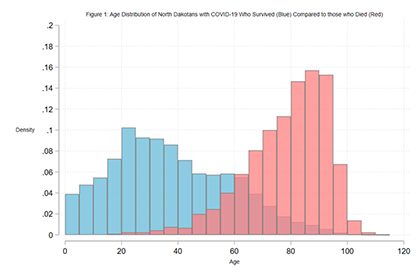Ask A Researcher
July 2023
The Social Variability of COVID-19 Mortality in North Dakota between March 11th, 2020 and February 13th, 2022

Avram Slone, M.A., is a research specialist with the Center for Social Research at North Dakota State University. He has previously worked as a research professional at the Alaska Justice Information Center in Anchorage, Alaska and as a statistical intern at the United States Census Bureau in Suitland, Maryland.The focus of his work at the Center for Social Research is on the disparate impacts of COVID-19 in North Dakota. He received his Master’s Degree in Sociology from the University of Kansas.
Acknowledgements
Research on the Social Variability of COVID-19 Mortality in North Dakota between March 11th, 2020 and February 13th, 2022 was made possible by a grant from the Centers for Disease Control and Prevention (CDC). This study, as well as others funded by the same grant, seeks to research COVID-19 disparities in underserved populations throughout the state of North Dakota. In particular, this article provides an overview of demographic and health factors associated with deaths due to COVID-19 in North Dakota.
Introduction
Since the first case of COVID-19 was reported in North Dakota on March 11th, 2020, COVID-19 has been among the most prevalent causes of death in the state. On March 26th, 2020, a 92-year-old man was the first resident of North Dakota to die from COVID-19. Between then and February 10th, 2022, a number of 2,121 North Dakota residents died from COVID-19 (0.25 percent of the state’s population). There are many socio-demographic, and health factors associated with COVID-19 incidence and death rates. These include age, race, gender, and the presence of comorbid conditions (medical conditions other than COVID-19 that are present at the same time in a person).
Data and Methods
The data used in this analysis were provided to the Center for Social Research (CSR) at North Dakota State University by the North Dakota Department of Health (NDDoH) and include demographic, geographic, and health details for every resident of North Dakota known to have contracted or suspected of having contracted COVID-19 between March 11th, 2020 and February 13th, 2022. Included among these data is the mortality outcome of each individual – in other words, whether or not the person died of COVID-19. For the purpose of this analysis, age, race, and gender variables were included, as well as an aggregate of the number of comorbid conditions experienced by persons infected with COVID-19. In the interest of simplicity, analyses in this article are limited to descriptive statistics comparing the mortality of COVID-19 across various demographic and health indicators.
Mortality Overall
The data provided by NDDoH report that 223,325 persons were infected with COVID-19 in the state of North Dakota between March 11th, 2020 and February 13th, 2022. As 2,121 of those persons died of COVID-19, we estimate that COVID-19 in North Dakota during that time frame resulted in the mortality of roughly one percent of persons known to have been infected.
Age
It is broadly accepted in the scientific community that COVID-19 presents the highest risk of mortality in older individuals (Mueller et al., 2020). The data in North Dakota support this assumption. According to US Census 2021 Population Estimates, the median age of North Dakota residents is 35.7 years (ND Compass, 2023a). The median age of persons infected with COVID-19 between March 11th, 2020 and February 13th, 2022 in North Dakota was 35 years. However, the median age of persons who died of COVID-19 was 81 years. Furthermore, 83.4 percent of North Dakota residents who died of COVID-19 were aged 65 or older. This indicates that although COVID-19 infects indiscriminately, the outcome is substantially more likely to be death when an older person is infected. Indeed, while the COVID-19 mortality rate for North Dakotans under the age of 65 was less than 0.2 percent, the mortality rate for North Dakotans aged 65 or older was 6.6 percent. Furthermore, the mortality rate at age 81 (the median age of COVID-19 deaths in North Dakota) was 15.7 percent. See Figure 1 for overlaid distribution of the age groups of those who survived COVID-19 (blue) compared to those who did not survive (red).

Race and ethnicity
While racial and ethnic diversity continues to grow in North Dakota, the state’s population is still largely White. According to the United States Census Bureau’s 2021 Population Estimates, 83.2 percent of North Dakotans are White non-Hispanic and 16.8 percent of the state’s residents are persons of color, making North Dakota the ninth least racially diverse state in the United States (ND Compass, 2023b). After the White population, the next largest racial groups in North Dakota are American Indian (5.7 percent), followed by Black (3.5 percent), and Asian (1.7 percent). In addition, persons of two or more races account for 2.4 percent of the state’s population and persons of Hispanic origin account for 4.4 percent of the state’s population. Statewide racial demographics are roughly consistent with the self-reported race of individuals included in the dataset: North Dakotans confirmed or suspected to have contracted COVID-19 during the data acquisition period who also self-reported their race were 85.0 percent White, 7.0 percent American Indian, 3.7 percent Black, and 1.6 percent Asian. Additionally, 2.8 percent were of two or more races and 4.9 percent were of Hispanic origin.
COVID-19 deaths with known races in North Dakota during the data collection period were 90.6 percent White and 7.0 percent American Indian. Both Black and Asian North Dakota residents accounted for less than 1 percent of deaths. Persons of two or more races accounted for 1.2 percent of deaths and persons of Hispanic origin accounted for 2.1 percent of deaths. While the data suggests that there may be a small discrepancy between the race of persons who survived COVID-19 and those who did not, one reason may be that the race of the deceased went unreported in 17.5 percent of COVID-19 deaths. In addition, racial diversity in North Dakota is not consistent across age groups: the older the age group, the less diverse the population (ND Compass, 2023d).
Gender
According to the United States Census Bureau 2021 Population Estimates, the population of the United States is 50.5 percent female and 49.5 percent male (United States Census Bureau, 2023). In North Dakota, however, an influx of mostly-male oil and gas industry workers has changed statewide demographics since the early 2000s, and the state of North Dakota is now more male than female, at roughly 51.4 percent male (ND Compass, 2023c). However, the gender of the people with confirmed or suspected COVID-19 cases does not match the male-female proportion of the state. During the data collection period, 51.6 percent of those persons with confirmed or suspected COVID-19 for whom there was a reported gender were female. Although the available data does not help to explain this disparity, one explanation may be because men are less likely than women to seek medical care, they are therefore less likely to test for COVID-19 or seek COVID-19 treatment (Courtenay, 2000). Despite the fact that more women than men were confirmed or suspected to have contracted COVID-19 in North Dakota, the majority of those who died of COVID-19 (55.5 percent) have been male. For a crosstabulation of COVID-19 mortality based on gender, see Table 1.

Comorbidities
In the study of any disease’s impact on the population it infects, it is important to consider how the disease affects persons with comorbid conditions. In this case, the study looked at how chronic illnesses other than COVID-19 impact persons infected with COVID-19 and compared it to how COVID-19 affected persons who did not have comorbid conditions. In the data provided by the NDDoH, 81.4 percent of individuals with confirmed or suspected cases of COVID-19 self-reported having no comorbid conditions. Another 12.4 percent reported having a single comorbid condition, and 6.2 percent reported two or more comorbid conditions.
Persons with comorbid conditions were more likely to die from COVID-19 than persons without comorbid conditions. While 18.6 percent of North Dakotans with suspected or confirmed COVID-19 had at least one comorbid condition, 57.1 percent of those who died had at least one. Furthermore, 38.4 percent of those who died had two or more comorbid conditions despite persons with multiple comorbidities accounting for 6.2 percent of North Dakotans who were suspected or confirmed to have contracted COVID-19. Among individuals with one of the nine categories of comorbid conditions recorded by the NDDoH, persons with asthma were the least likely to die from COVID-19, with less than 0.8 percent of those who reported asthma as a comorbid condition dying. Persons with renal diseases and emphysema and COPD were the most likely to die from COVID-19, with 15.1 percent of those who reportedly had renal disease as a comorbidity and 15 percent of those who had emphysema and COPD ultimately succumbing to COVID-19. For a complete list of comorbidity categories and their associated COVID-19 mortality rates, see Table 2.

Conclusions
According to the Centers for Disease Control and Prevention, COVID-19 was the third most prevalent cause of death in the state of North Dakota in 2021 (CDC). Data provided by the North Dakota Department of Health to the Center for Social Research at North Dakota State University indicates 2,121 persons living in North Dakota died of COVID-19 between March 11th, 2020 and February 13th, 2022. This means that 0.25 percent of all North Dakotans died from COVID-19 during that time frame, and roughly one percent of all North Dakotans who were confirmed or suspected to have contracted COVID-19 during that time frame ultimately succumbed to the disease.
An examination of commonly recognized differentiating factors in COVID-19 mortality (age, race, gender, and the preexistence of comorbid health conditions) revealed that COVID-19 mortality varied across those factors. Regarding age, COVID-19 mortality among persons infected with COVID-19 was much higher in older persons than it was in younger persons. Less than 0.2 percent of COVID-19 infected persons under the age of 65 died from COVID-19, compared to 6.6 percent of those aged 65 or older. Regarding race, COVID-19 infected persons in both the White and the American Indian populations had higher-than-expected COVID-19 mortality rates given their proportion of COVID-19 infections when compared with the racial distribution of population overall. One possible explanation for this is that because of the shifting racial demographics of the state, older age groups are less racially diverse than younger age groups, and COVID-19 deaths are more common amongst older individuals. However, missing data in this category makes it difficult to accurately assess the impact of race on COVID-19 mortality in North Dakota. Regarding gender, most confirmed or suspected cases of COVID-19 in North Dakota were in women, consistent with the finding that women are more likely than men to seek medical care when they are feeling unwell. Alternately, mortality was higher in men than women. Men accounted for approximately 56 percent of deaths while accounting for only 48 percent of infections. Regarding comorbidities, persons who had two or more medical conditions other than COVID-19 were much more likely to die from COVID-19 than persons who did not report any comorbidities. While only 18.6 percent of North Dakotans who contracted COVID-19 reported any comorbidities, more than 57 percent of those who died had at least one comorbid condition and more than 38 percent had two or more. Among those who reported comorbidities, persons with renal disease and emphysema and COPD were the most likely to die and persons with asthma were the least likely to die from COVID-19.
References
Courtenay, W. H. (2000). Constructions of masculinity and their influence on men's well-being: A theory of gender and health. Social Science & Medicine, 50(10), 1385–1401. https://doi.org/10.1016/s0277-9536(99)00390-1
Mueller, A. L., McNamara, M. S., & Sinclair, D. A. (2020). Why does COVID-19 disproportionately affect older people?. Aging, 12(10), 9959–9981. https://doi.org/10.18632/aging.103344
National Center for Health Statistics. North Dakota. (n.d.) Retrieved June 23,2023, from https://www.cdc.gov/nchs/pressroom/states/northdakota/nd.htm
North Dakota Compass. –Demographics. Age - North Dakota Compass. a (n.d.). Retrieved January 23, 2023, from https://www.ndcompass.org/demographics/key-measures.php?km=age#0-11491-g
North Dakota Compass. Demographics. Race - North Dakota Compass. b (n.d.). Retrieved January 23, 2023, from https://www.ndcompass.org/demographics/key-measures.php?km=race#0-6977-g
North Dakota Compass. Demographics. Population - North Dakota Compass. c (n.d.). Retrieved January 23, 2023, from https://www.ndcompass.org/demographics/key-measures.php?km=population#0-7943-g
North Dakota Compass. Demographics. Age - North Dakota Compass. d (n.d.). Retrieved January 23, 2023, from https://www.ndcompass.org/demographics/key-measures.php?km=age#0-6609-g
U.S. Census Bureau quickfacts: United States. (n.d.). Retrieved January 23, 2023, from https://www.census.gov/quickfacts/fact/table/US/LFE046221
